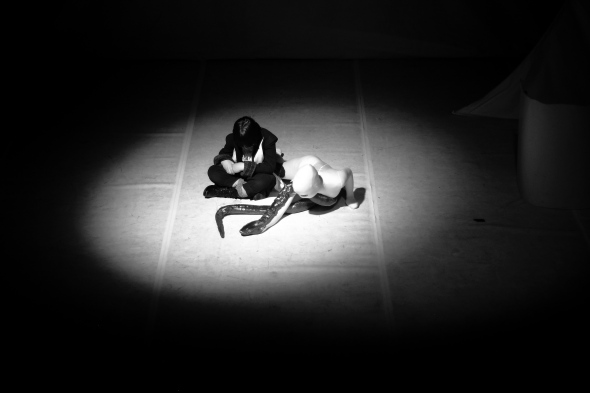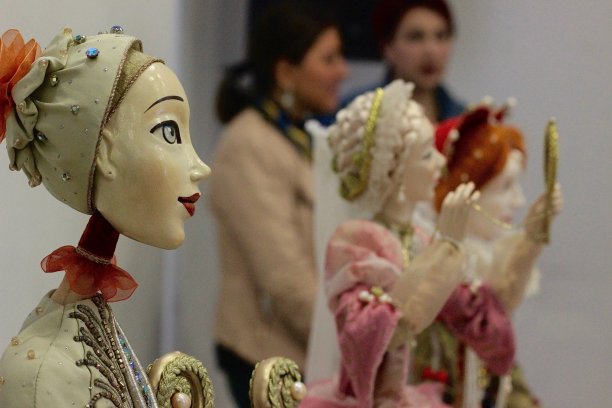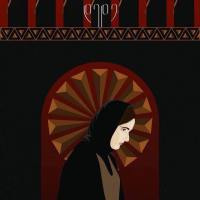Tojina Checkmate

A tojina on World Puppetry Day
While in Tbilisi I also hunted down puppets in other places. (Puppet = თოჯინა or tojina; plural = თოჯინები or tojinebi; puppetry also = tojinebi.) One of the places I ended up in, which I need to return to, is the Movement Theatre, which was located in Mushtaidi Park near the National Stadium. The Movement Theatre was not a puppet theatre per se but incorporates puppets into its performances. They also mingled dance, electronic music, acrobatics along with puppets into an unusual stew. They had a definite post-apocalyptic patchwork style in their cluttered foyer. Stacks of manikins decorated the lawn. The one show I saw was more of a dance performance in many ways than any sort of traditional play or puppet show. It was definitely an edgier vibe than the other theatres. And will be well worth further exploration.
I also stopped in at the pantomime theatre, which seemed to be in some ways like the black theatre shows in Prague, stylish but low on substance. More for visitors than serious art. About half the show kept my attention.
I mentioned in my last essay that I had run into Nino Namitcheishvili and she had invited me to a puppet performance of Antoine Exupery’s classic Le Petit Prince / The Little Prince. And soon it was time to wander over to the upper room of the Marjanishvili Theatre to watch Nino’s project. Nino gave me access to the light and sound booth so I had a chance to watch the whole performance give in the black box style theatrical space. ‘Black box’ means essentially there is no stage, just a square performance space with chairs usually on one end. Although in this case it was really a white box. White for the desert landscape.

The Little Prince at the Majanishvili Theatre

- The Snake Puppet
The style was a mixture of live actors and puppets. The prince in particular was played by a young boy. And the denizens of the planets visited were mostly puppets. Lighting and visuals were important for setting the mood, especially in the unforgiving white environment. And the puppets were again, as in Gabriadze and the Tbilisi State Puppet Theatre, a modified Japanese bunraku style. More than one puppeteer moved the puppets from behind with little rods in the puppets. Bunraku would not have the rods. And the puppeteers were clothed in clothing appropriate for the performance, rather than all black. But I had seen variations of this style at The Little Theater in London, in Prague, and at ESNAM, the international puppet school in Charleville France. The puppets were creatively made. And one figure stood out, a woman all dressed in futuristic blank white to blend in with the desert environment was attached to a shiny scaly snake puppet, thus avoiding the use of strings or rods and giving it a much more sinewy movement. Nino had come up with this idea as a way to give more life to the snake. Seductively done. Serpent and Eve in one.

Head or hand? Unusual design in a doll.
Meanwhile March 21st was approaching. March 21st is World Puppetry Day. An idea that has been around since the year 2000. In Alaska the day would pretty much come and go without fanfare. But here it was taken fairly seriously, at least by the Tbilisi State Puppet Theatre. And one of the things, besides performances of ‘Georgia’, they did was to organize a tojina exhibition. Now I need to tell you one thing that will become more important as this story goes on. In Georgia the word tojina means both ‘doll’ and ‘puppet’. There are many cultures in the world for whom this is the case. And then as in English there are cultures where it is very different. And often when I spoke to people, even puppeteers in Georgia, they didn’t make the rather hard separation between the doll and the puppet that we make. And in fact more than once I did not know which the Georgians were referring to. And so the tojina exhibition turned out to be a doll show.
And what an interesting doll show at that. Dolls in America tend to be of a certain nature. I wouldn’t last very long at an American doll show. It would be like swallowing a cup full of artificial sweetener. Don’t believe me? Search the words ‘doll show’ in English. Then stand back with an insulin injection at the ready. And when the dolls aren’t cute they tend to be kitschy. Or maybe that’s the same thing. Even the ‘creepy’ dolls tend to be postmodern ironic cute. And for a break one gets the big eyed anime dolls. The only interesting trend is the BJD dolls (ball jointed doll), a Japanese idea, that has moved through other cultures, though not without its own issues. There is of course a separate world of genre plastic models and related superhero geek dolls found at comic book and fantasy conventions. And then there are art dolls, but they seem to show up less in the sweet world of the American doll and more in art galleries.
Maia Aladashvili’s detailed Tojinebi (Click for larger images)
But here at the old Silk Factory gallery these dolls were serious art, without trying to be edgy or countercultural. They were dolls as a classical art. And truthfully one could see that dolls being confused with puppets was indeed a very good thing for Georgian doll makers. Because many of the dolls seem to be telling stories. Rather than babies and Barbies these dolls had more character and presence. I was impressed. No mean feat. And indeed one could see a connection between puppets and dolls here. Whereas in America a puppet play made with anything resembling the average American doll would be something done in the worst possible taste, either inadvertently or on purpose to deconstruct the point.

Clown Tojina
Speaking of tojinebi, I was searching for a puppet museum. I had already finally gotten into the astounding Puppet Animation Museum of Karlo Sulakauri. (Do read about that here!) But I was also looking for a tojinebi museum that was listed on a map as existing near the Gabriadze Marionette Theatre. I walked to the spot on the map. It was no longer there. In it’s place was an industrial black shiny postmodern box instead. In a conversation with Elene Murjikneli at Budrugana Gagra she told me one day it was simply closed. Soon the building was gone as well. And no one knew what happened to the tojinebi. Ana Sanaia though said she knew. And she gave me an email of a women who could tell me, Nini Sanadiradze, the director of the Union of Tbilisi Museums. (This is not a union as Americans often think of the word. It is more of a civil department.)

Dolls with a story to tell.
I got together with Nini Sanadiradze at her office on Agmashenebeli Avenue. I told her of my documentary project and how I was looking for the missing puppet museum. She said she had the tojinebi in storage, which unfortunately I couldn’t see. But she did have a mock up of a rather exciting book of the collection. As she showed it to me I realized that most of the tojinebi were dolls. Wonderful dolls. Not so many puppets. She also told me of her difficulty in getting good workers in her museums. She said that eventually she wanted to rebuild the tojinebi museum. There was a potential plot of land that she showed me on a map. All very interesting. It was a pleasant two hour visit. She told me to get in touch with her again before I left, she wanted to show me the work she had done on the Nikoloz Baratashvili House Museum.

Tojinebi Show on World Puppetry Day
I contacted her a week and half later and we made an arrangement to meet at the museum. I met her early Sunday afternoon again down near the Gabriadze Theatre. She showed me how she had remodeled the building and redesigned the exhibition. She was proud of what she had done with good reason. We then sat on the veranda and talked for another hour or so. I had thought we might discuss Georgian puppetry more but the conversation turned in a different direction. She said ‘I’d like to offer you a job.’ I was slightly taken aback. ‘Doing what?’ I replied. I didn’t imagine myself simply working in a museum. ‘I’d like you to work with the tojinebi museum.’ ‘But there isn’t one.’ ‘Yes’ she replied calmly. ‘So do you want me to help organize the museum?’ ‘Yes.’ she replied. I was a little skeptical. ‘Well right now you have many more dolls than puppets. Can we get more puppets and have a room for them?’ ‘Of course.’ she replied in the same level voice with just a hint of a smile. So I threw this out. ‘Can we have a performance space?’ ‘Of course.’ she replied again. ‘Can we have a room that is hands on for dolls and puppets and for workshops?’ ‘Of course.’ she replied steadily. I put out a few more questions and then I came to this, thinking of the old tojinebi museum. ‘Look,’ I said ‘When people build new buildings these days they tend to make bad postmodern monstrosities. Can we make a modern building that looks like it belongs in Georgia, with elements of classic Georgian architecture?’ ‘Of course.’ She replied steadily and indeed smiling. Finally I just said ‘Okay you got me.’

Nini Sanadiradze asking an important question.
I had been thinking about something like this for a while now. I was leaning more and more towards wanting to come back to live. I had made some very good friends. I had made excellent connections. I had been intellectually and creatively stimulated. When I talked with folks about music or puppets I had had rich conversations. When I had told various people about my music collection they suddenly perked up, wanting to hear more. Someone had suggested possibly getting me to lecture over at the state university. And there were many other possibilities. And now this…

Faces that look like people I met in Tbilisi
Before I left Alaska, having put my life into storage, getting ready to spend six months in Europe and Georgia, more than one friend asked ‘Are you planning to move to Europe? Or Georgia?’ My answer was always the same. ‘I’m not planning to move there? But I’m not planning on NOT moving there either.’ I was simply open. It seemed like a time for considerations of things that had formerly been off the table. There was a moment in France when I briefly considered living there. But it was a passing speculation. But since I had been in Georgia I went from wondering why I was even there, especially during the long holiday season when it seemed like I could barely contact anyone. To finding the scales weighing more and more in favor of coming back to this place to live. And now I would say that everything had gone from 60/40 in favor of coming, to 80/20 before I spoke with Nini, to 98/2 with the 2% uncertainty being simply for the unpredictability of life.
I felt I had been in a game of chess with God and now he had me in checkmate. This was the road forward. I would go back to Alaska to finish my commitments for the summer, to say farewell. But Europe now had me.

A doll of Georgian actress Sofiko Chiaureli from her role in The Wishing Tree
More next time as we start to say our farewells to Georgia and go out on a small full dress tour with Erisioni.
Byrne Power
Haines, Alaska
5/3/2018















Pingback: Georgian Farewells | GRAVITY FROM ABOVE
Pingback: Georgian Lessons #10: Georgia Without Blinders | The Anadromous Life
Pingback: Gravity From Above: A Personal Reckoning | GRAVITY FROM ABOVE
Pingback: The Georgian Book of Dolls | GRAVITY FROM ABOVE